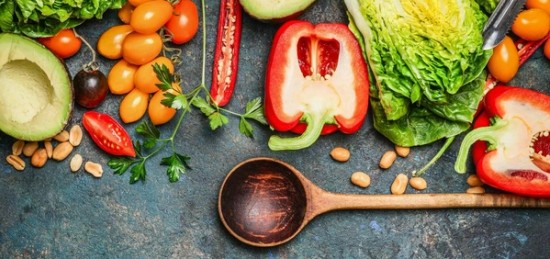By Caroline Young, MS, RD, LD, RYT
We’ve heard it since we were kids: Eat your veggies.
But they are classically the food on the dinner plate that is least exciting, and for some, eating vegetables has felt more like an obligation than a pleasure.
Now, veggies are where it’s at. In fact, chefs throughout the country are making them the priority instead of the afterthought.
Nutritionally, the buzz around veggies is a major positive, because they give us essential nutrients to help us maintain a healthy mind and body, such as fiber, potassium, and vitamins C and E. Eating fruits and veggies can also help reduce risk of some chronic diseases, like heart disease and cancer, when they’re part of an overall healthy diet.[1]
Despite their rising popularity, Americans are still not eating enough vegetables on a daily basis.[2]
But you don’t have to go to culinary school to put more of an emphasis on veggies at home. By adding a few ingredients that are probably already in your pantry, you can add flavor and more nutrients to your veggie dishes.
Check out these simple yet tasty ways to make veggies your favorite part of every meal:
Pair with Pesto. The classic Italian sauce isn’t just for pastas and pizzas. Roast carrots in the oven and top with pesto made with peanuts which are heart-healthy, and to add flavor. Scientific evidence suggests, but does not prove, that eating 1.5 ounces per day of most nuts, including peanuts, as part of a diet low in saturated fat and cholesterol, may reduce the risk of heart disease.
Get Saucey. Drizzle your favorite veggie with a simple sauce. Like spicy stuff? Try Simple & Spicy Lime Peanut Sauce made with peanut powder. Or mix your favorite hummus and balsamic vinegar to make a creamy sauce.
Make it Crunchy. Sauté your spinach or kale and top it them off with a handful of chopped peanuts. You’ll add texture, fiber and protein to your greens. Also, check out this roasted vegetable and peanut salad recipe. The added fiber and protein from the peanuts can help you feel fuller longer.[3]
Be Cheesy. Make your Brussels Sprouts irresistible and serve each portion with a dollop of creamy goat cheese on top. Or roast cauliflower in the oven with whole, unwrapped garlic cloves, and mix in some Parmesan a few minutes before it’s ready.
Give it an Eastern Flare. Make a simple veggie curry by combining a curry paste with canned coconut milk in a deep skillet. Add mushrooms, onions and garlic, any other veggies of choice, and cook until softened.
Spice it Up. Invest in a few shelf-stable spices like cumin and turmeric, and sprinkle them on your veggies to give them a little kick.
Go Green. Pick up some dried or fresh herbs, like rosemary or thyme, and add them to your roasted veggies. Both herbs and spices boost flavor without adding sodium.[4]
Take it to go. Blend your veggies in a smoothie with water or milk, and yogurt and/or peanut butter for protein and fat. Start with the liquid, add your protein and top with your veggies. Throw in your favorite fruit for a little sweetness, add a few ice cubes in the mix if you need to thicken your veggie drink. Or you can always pour your smoothie in a bowl, top with a handful of peanuts, granola or fruit. Need a smoothie recipe? Try a chocolate peanut butter green smoothie.
(To give your mind and body enough essential nutrients, the USDA recommends a certain amount of daily vegetables. Ladies, aim for at least 2-2.5 cups of veggies daily. Men, shoot for a minimum of 2.5-3 cups daily.)[5]
[1] Nutrients and health benefits. Choose MyPlate. https://www.choosemyplate.gov/vegetables-nutrients-health. Published January 12, 2016. Accessed February 13, 2017.
[2] Adults Meeting Fruit and Vegetable Intake Recommendations – United States, 2013. Centers for Disease Control and Prevention. https://www.cdc.gov/mmwr/preview/mmwrhtml/mm6426a1.htm. Published July 10, 2015. Accessed February 13, 2017.
[3] Fiber. https://medlineplus.gov/ency/article/002470.htm. MedlinePlus. Reviewed August 17, 2014. Accessed February 13, 2017.
[4] Choose Foods and Beverages with Less Saturated Fat, Sodium, and Added Sugars. Choose MyPlate. https://www.choosemyplate.gov/sodium. Updated January 7, 2016. Accessed February 13, 2017.
[5] All About the Vegetable Group. Choose MyPlate. https://www.choosemyplate.gov/vegetables. Updated July 26, 2016. Accessed February 13, 2017.
